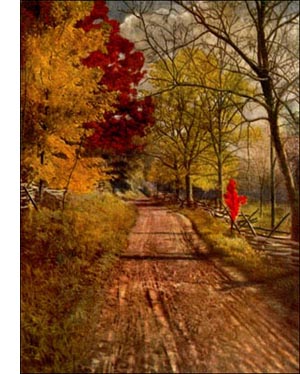Weeping Spruce Tree
 Weeping Spruce (Picea Breweriana, Wats.)-Tree 75 to 125 feet high, with swollen base and tapering shaft; branches drooping and crowded, to the ground; twigs remarkably long and slender. Bark brick red, thin, scaly. Wood soft, close grained, satiny, pale brown, heaviest of native spruces. Buds conical, small, scaly, brown. Leaves flattened on the upper side only, blunt, pale above, dark green and lustrous beneath, 3/4 to 1 1/4 inches long. Flowers: staminate rich purple; pistillate oblong; scales broad, rounded, turning out at edge, with cut-toothed bract under each. Fruit slender cones, 2 to 4 inches long, tapering, stalked, purple turning to orange-brown, opening in autumn, but hanging a year empty; scales broad, entire, thin, turning backward; seeds winged. Preferred habitat, dry ridges on mountains near timber line. Distribution, elevation 4.000 to 7,000 feet, California and Oregon. In isolated groves in coast ranges.
Weeping Spruce (Picea Breweriana, Wats.)-Tree 75 to 125 feet high, with swollen base and tapering shaft; branches drooping and crowded, to the ground; twigs remarkably long and slender. Bark brick red, thin, scaly. Wood soft, close grained, satiny, pale brown, heaviest of native spruces. Buds conical, small, scaly, brown. Leaves flattened on the upper side only, blunt, pale above, dark green and lustrous beneath, 3/4 to 1 1/4 inches long. Flowers: staminate rich purple; pistillate oblong; scales broad, rounded, turning out at edge, with cut-toothed bract under each. Fruit slender cones, 2 to 4 inches long, tapering, stalked, purple turning to orange-brown, opening in autumn, but hanging a year empty; scales broad, entire, thin, turning backward; seeds winged. Preferred habitat, dry ridges on mountains near timber line. Distribution, elevation 4.000 to 7,000 feet, California and Oregon. In isolated groves in coast ranges.It is somewhat embarrassing to the hard-working horticulturist in the East to be asked his opinion of the weeping spruce. He regards it as one of the most distinct of the spruces, admirable in habit and beautiful in foliage-an ideal tree for ornamental planting-but he cannot make it grow! His most careful efforts have brought only failure. A tree that belongs to "dry mountain ridges and peaks near the timber line " has a good excuse for languishing in gardens on the wrong side of the continent. And such a range puts the species out of reach of lumbermen for a decade or two yet. The uses of this tree must be put down without reference to man's ineffectual yearnings to claim it for his own. It fulfils Nature's plan, lifting its graceful spire into the clouds and hanging out its purple flowers where there is no human eye to see.